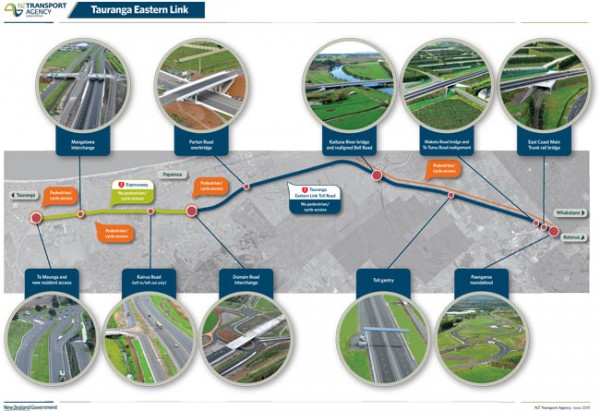New Zealand’s newest stretch of state highway – the Tauranga Eastern Link (TEL) - will open to traffic on Monday August 3.
The $455 million NZ Transport Agency project delivers 21 kilometres of four-lane, median divided highway between Tauranga and Paengaroa.
After four and a half years of construction the road was officially opened today by Prime Minister John Key and Transport Minister Simon Bridges.
Following a community day onsite on Saturday August 1, it will open to traffic on August 3.
The Tauranga Eastern Link is the second of seven Roads of National Significance (RoNS) based around New Zealand's five largest population centres to be fully completed, following Auckland’s Victoria Park Tunnel in 2011.
The RoNS have been identified by Government as key projects for moving people and freight between and within these centres more safely and efficiently.
The Transport Agency’s Waikato/ Bay of Plenty Regional Director, Harry Wilson, says the new road will leave a lasting impression on the Bay of Plenty region, bringing many social benefits and opening up further economic opportunities in the Eastern Bay of Plenty. It will also provide more predictable travel times, which is critical to business attraction and growth.
“The Tauranga Eastern Link (TEL) has been designed to support the growth of the Bay of Plenty, reduce travel times and improve safety,” he says.
“It will be a strong anchor to support managed land use in a planned and sensible progression in this region.”
The TEL brings the East Cape and the central North Island closer to the Port of Tauranga.
“The road shaves off around 12 minutes when compared to the old route, which means some freight operators will be able to complete an extra trip each day.
“The new road will also significantly improve safety, reducing the amount of death and serious injury crashes in the region.”
The TEL goes from Te Maunga in Tauranga through to the new Paengaroa roundabout, which replaces the former junction of State Highways 2 and 33 (the Rotorua and Whakatane highways).
The project involved 550,000 square metres of new road, more than three million cubic metres of earthworks and saw seven new bridges built. All up there were more than 1.5 million hours worked.
New intersections have been constructed for Sandhurst Drive, Domain Road, and Paengaroa junction (SH2/33), along with a new overbridge for Parton Road, and underpass for Maketu Road.
“It was a huge undertaking that is considered one of the most challenging major projects in New Zealand due to the soft ground conditions,” says Mr Wilson.
The TEL boasts a shared 6.8 kilometres long walking and cycle path, more than 300,000 native plants and two large scale public artworks. One of the artworks is a 130m long pa sculpture, the largest public art pieces currently on display in New Zealand.
The sculptures, by renowned New Zealand artist Regan Gentry highlight and celebrate the rich cultural history surrounding the route.
As with all projects of this size there have been some challenges along the way, such as the unexpected fire at the Domain Road interchange in November 2014, but Mr Wilson says the TEL project team quickly recovered from that setback.
“The TEL project team, made up of Fulton Hogan HEB Construction Alliance (FHHCA), the Transport Agency and Beca, tackled all of the challenges head on,” he says.
“Their hard work and dedication has ensured we finished construction five months ahead of schedule.”
TEL project director Andrew Johnson says the FHHCA is delighted with the finished project.
“Being one of the most geotechnically challenging major roading projects in New Zealand, the FCCHA designers have done a superb job of using old and new design and construction methodologies to overcome the challenges of the soft ground conditions at the site,” he says.
“The whole project team have done an excellent job and have produced a first class product.”
Mr Wilson says the support and foresight of local councils, councillors and other advocates has been invaluable and has helped this project come to fruition.
“ I look forward to watching this region reap the rewards of this much anticipated project,” he says.
“A big thank you must also go to the local community who have been driving through road works for the past four and a half years.
“Thank you for your patience. We hope you enjoy driving on the TEL as much as we enjoyed building it.”
For more information and other images go to: www.nzta.govt.nz/tel(external link)

View larger map [PDF, 1.8 MB] of the Tauranga Eastern Link.
Third time lucky – the TEL underwent three name changes: the Te Puke Bypass, the Tauranga Eastern Arterial and finally the Tauranga Eastern Link, when it was recognised as a road of national significance and upgraded to a four lane highway.